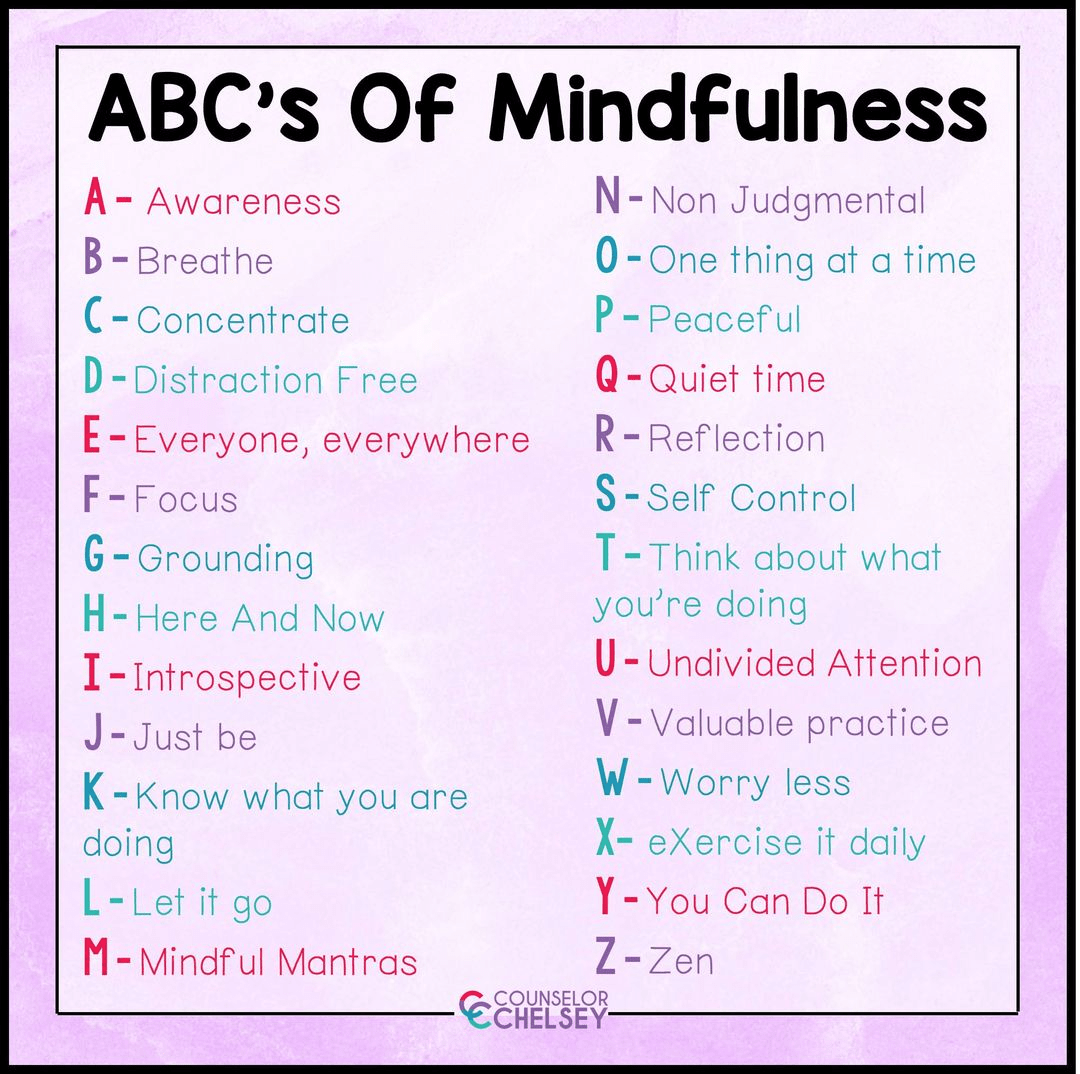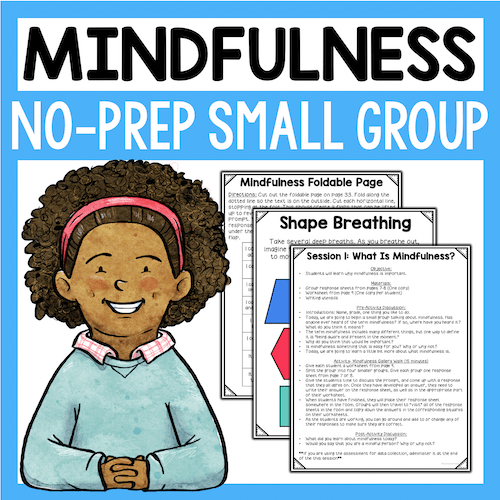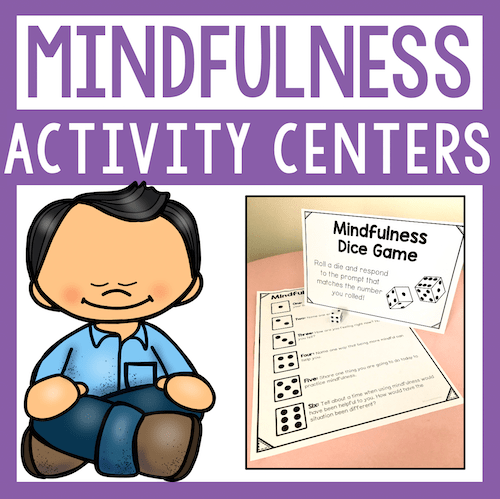What You Need To Include In Your Next Mindfulness Small Group
You’ve decided to do a mindfulness small group at your school. You know about the benefits of mindfulness could really help your students. You feel excited about the transformation you’ll see in your students.
But then the doubt sets in.
What will you actually DO with the kids once they’re in the group?
What activities can you include to make sure students gain a solid understanding of what mindfulness is and how to use it?
Small groups are great, but planning them can feel like a lot of pressure. That’s why I put together this post of my favorite mindfulness small group activities! My hope is that these ideas eliminate the stress of lesson planning so you can focus on enjoying the time with your students.
#1. Clear Up The Confusion
Mindfulness can seem like an abstract topic, especially for kids. It’s likely that students will come into your group with a lot of different perceptions about mindfulness. Maybe these ideas come from TV, social media, or peers. Some students might think of mindfulness as sitting quietly, or some might only think of it as a religious practice. Some might have no clue what it is.
If they don’t know what it means, it’ll be harder for your students to be able to practice it. That’s why one of the most important ideas to cover in your group will be defining what mindfulness is, and what it isn’t.
Use some of these words to describe mindfulness to your students!
To do this, you’ll want to have a clear definition that’s easy to understand. The definition I use is “being aware and present in the moment.” This includes not focusing on the past or future, but noticing what is happening right now.
Even with a clear definition, some students, especially younger ones, might be a little confused. To clear up any remaining confusion, it’s a good idea to also give some examples. Give a few examples of what mindfulness could look like at school and at home. Then, give some examples of what mindfulness isn’t.
For a more engaging lesson, you can give examples and ask students to vote on whether or not they describe mindfulness.
Here are a few examples you can use:
Gunnar thought about what he was going to say before he said it.
India noticed that she was starting to feel frustrated with her friend, so she walked away to calm down.
Avery was running in the hallway and bumped into her teacher.
Fabian yelled at his sister when she stepped on his toe.
Starting your group by giving students a clear definition of mindfulness, will give them a strong foundation to build on in future lessons.
#2. Explain Why Mindfulness Matters
After they learn what mindfulness is, students need to know why it matters. If the students in your mindfulness small group know why the information matters, they’ll be more likely to pay attention and learn.
Thankfully, mindfulness has many benefits that you can share with your students. An article from Kids Health shows mindfulness can help kids increase their focus, manage their emotions, get along better with others, and more.
While students will certainly be interested in experiencing these benefits of mindfulness, it’s also important to talk about how mindfulness can impact them specifically.
One activity to help with this is talking about each benefit and asking students to share how that benefit would change their lives/behaviors.
For example, you can begin by talking about how mindfulness increases focus. Then, ask students to share areas of their lives where it’s hard to focus. For example, students might say homework, music class, etc. Then, ask what their lives would be like if it was easier for them to focus in this setting. You can also share your own example. For me, I can sometimes get worried about things I can’t control. So, mindfulness can help me feel more calm and remind me to focus on what I CAN control.
Making it clear how mindfulness can specifically benefit the students in your small group can be increase buy-in from students.
#3. Practice, Practice, Practice
Like any other skill, students will become more comfortable with mindfulness the more they practice it. For some kids, mindfulness might not come naturally. They might be used to playing video games, or always being on the go. Mindfulness is a change of pace.
Not only do students need to get a lot of practice using mindfulness, it’s also important to give students a variety of strategies. What might work well for one student, might not work for another. Also, certain strategies can’t be used in some settings. For example, mindful coloring might not work if a student is in class or in the car.
When we continue to add a variety of mindfulness tools to the students’ toolboxes, we set them up for success! Giving kids the opportunities to practice these strategies while they’re calm, makes it easier for them to practice mindfulness when they’re upset.
Here Are Some Mindfulness Strategies To Try:
Deep Breathing: This can be done in many ways. To add some extra fun, use pinwheels or bubbles to help students see their breathing.
Grounding: Lead students through an exercise where they use their 5 senses to notice what’s around them. They will find 5 things things they can see, 4 things they can feel, 3 things they can hear, 2 things they can smell, and 1 thing they can taste.
Mindful Mantras: Help students choose statements they can use when they are wanting to be mindful. Examples include: “I am in control.” “I will focus on the present.” “I am safe,” etc. They can decorate a sheet of paper with their mantra.
Do A Feelings Scan: Give students 30 seconds to think about how they are feeling. Then, give them time to notice the feeling in their bodies. Prompt them to consider which parts of their bodies are tense, hot/cold, etc.
During your small group time, give students time to explore these different mindfulness strategies. Then, encourage them to share about which techniques they liked the most and that they think will be helpful in real life scenarios.
This activity from my NO PREP mindfulness group helps students practice different deep breathing techniques.
#4. Make a Plan For Mindfulness
It’s important to talk about why mindfulness is important. However, we also need to explicitly teach students how and when they can use the strategies they have learned. Helping students make a plan for using mindfulness is an impactful activity to use as you close out your mindfulness small group.
To do this, encourage students to think about times in their lives when mindfulness could be helpful. For example, when they are walking through a busy hallway, when someone says something rude, or when they feel anxious about a test.
Once they have identified several settings in which they could benefit from being more mindful, encourage them to think about specific strategies they can use. Making a clear plan with your students will increase their likelihood of taking action on the information they have learned.
It can also be helpful to have students write down their plans and keep them as a reminder of how they can be more mindful. They can hang them in their bathrooms at home, lockers, etc. to make sure they remember the mindfulness strategies that will be helpful to them!
Planning a small group can be overwhelming and intimidating. These mindfulness small group activities will eliminate the doubt and pressure of the planning process and set you and your students up for success.
If you want your group to be even easier, check out my 6 session NO-PREP mindfulness small group plan. It includes everything you need to cover the topics we’ve already talked about and more! Plus, it’s completely print and go, which is perfect for busy counselors like you. So click the black box below to check it out!









